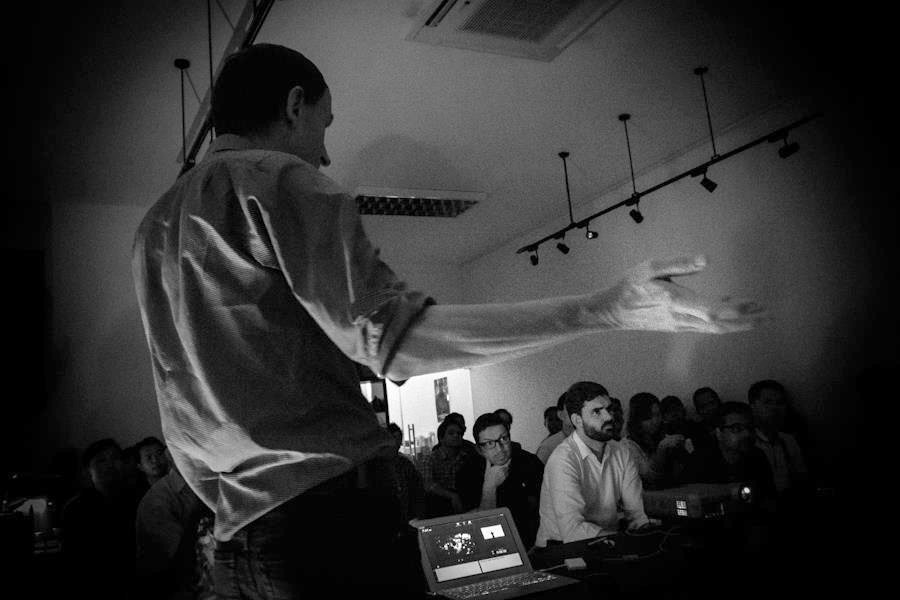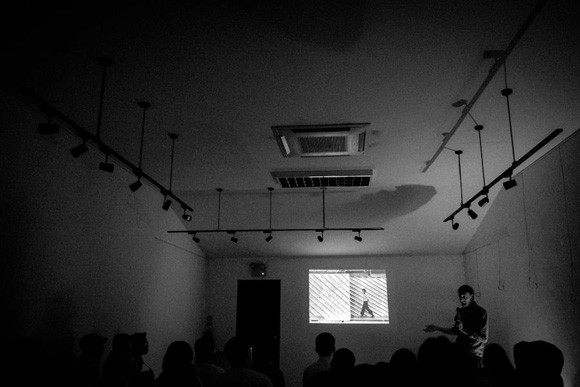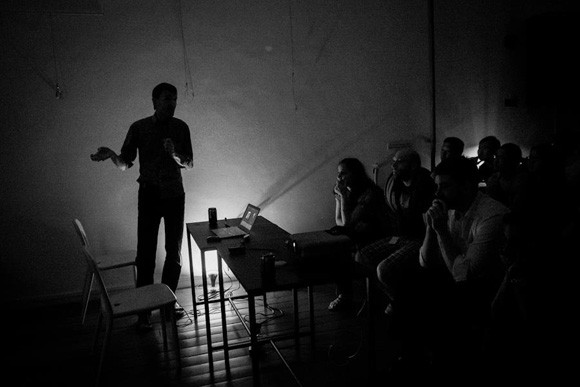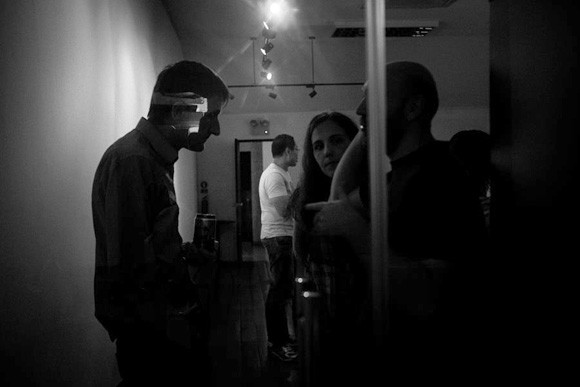
We hosted a public talk by photographer David Gibson, one of the co-founding members of In-Public Street Photography Collective, at IPA Gallery on Thursday 12th July, 2012. Here’s an A-Z summary of what David had to share…
Approaches – “Photographs need not be sharp. I have tried shooting at one-eighth of a second. I will shake the camera to get light streaks. I try to get away from the normal kinds of photography I do. I have tried fashion and portraits. I am not against trying polaroid and panoramic cameras.”
Branding – “It is a good thing to be recognized by your style. The best way to develop a style is keep photographing and your style will emerge. I was obviously influenced but it’s a mystery how mine developed the way it did. There are many styles but always room for everything. I am not sure what are the “in” styles though.”
Colors – “I started out with black and white (B&W). I eventually got bored and wanted new challenges. There was a period when I went out with two cameras, one with color and one with B&W film. But I got confused and eventually gave up.“
Composition – “I often start with the background forming fifty percent and wait in desperation. I hope to make it complete. I line up the image and need to be careful when I lift the camera. Once the subject chose to wait by standing behind me. It completely killed the photo.”
Dislikes – “I don’t like it when people just do street portraitures or use long lens. The former is not strictly street photography and the latter is just being lazy.”
Exposures – “I do not take a lot of photographs. I do have boxes of negatives but never more than 140 rolls of film per year. I do take more with digital but I delete. I am very selective and I sort of know when it works”
Fancy – “Sometimes you take photographs because you like what you see. It does not have or need to be a great photograph.”
Frequency – “I always carry my camera but I don’t shoot all the time. I try to set days aside though I am not as frequent. I constantly feel the responsibility to take a photograph. It’s an itch that has to be scratched.”
Gifts – “You never know what people will do and they do the strangest things. They are gifts to the photographer. I wander around and see these odd gifts. You have to take, i.e., photograph these gifts.”
Gratitude – “You settle for what you get. You may envision the perfect photo but you have to settle. The idea is to see something, photograph it and often it becomes something more.”

Hats – “I wear different hats with photography.”
In-Public – “We are a bunch of friends of photography. However, there is a responsibility to keep up. We are on our toes as we are criticized for not doing more. It’s not easy. We are 21 photographers all over the world and we do not have a leader.”
Innocence – “I love the idea of innocence and hanging onto it. I think the concept of innocence is important and inspiring. I constantly come back, to view the world with a child-like wonder and curiosity.”
Invisibility – “I don’t stand out. I have this idea that I am half invisible. I actually believe I am half invisible. I don’t get caught. I don’t have interactions with my subjects. Maybe I am lucky but I have more issues with security personnel than the public.”
Jobs – “I started out in social work. I was not conscious and unsure how I became a professional photographer. I am an amateur at heart and I don’t see photography as a job. I studied photography not because I needed to be a photographer. It was never a necessity. When I become a full-time photographer, I have to change gear and up the notches but I try to remain an amateur.”
Kids – “It is not a comfortable subject. There are lots of nervousness, particularly for a man to follow children around and not be perceived as a pervert. It is a sensitive subject especially in the United Kingdom and many photographers will not consider children as a subject.”
Luck – “There is a sense of tension when something is about or has happened. Little bits of luck are constantly at play.”

Lines – “A lot of my photographs suggest a narrative and some have served as book covers.”
Moments – “My right moment to photograph is the wrong moment for my subjects to be photographed, i.e., catching people at their awkward moments.”
Nuggets – “I photograph mostly conscious of the frame. There are small nuggets, or hidden details in photographs that you realize only after the photograph was taken.”
Obsession – “I find it a sacrilege to convert my color RAW files to B&W. If I have a book, there will be two different sections. If I want to photograph in B&W, I prefer to use film.”
Projects – “I preach that having a project is a good idea but I don’t actually follow the rule. I know I should but I have this general and vague project, an idea of wandering around. I liken it to having a dog and needing to take the dog for a walk. Photography doesn’t get any easier and having a project helps.”
Proximity – “I work primarily with a 50mm. I don’t get that close.”
Quality – “I do not take pictures for the sake of taking it. Taking a half decent or rubbish photograph does nothing for me.”
Roots – “I am rooted in the B&W tradition of Magnum photographers like HCB and Elliott Erwitt.”

Street Photography – “Street Photography has become popular. When I started photography, I was not aware of the term. Back then it was either humanistic photography or documentary photography. Trent Parke is not a street photographer, he is a fine art photographer. Cartier Besson would probably consider the label of street photographer an insult. The label of street photography is one of convenience. It is essentially a community of the street. I don’t know if the bubble will burst some day.
Street Photography is photographing what happens outside your front door. It must not be set up and it is about everyday life. Its coverage is big and does not need to feature people.”
David resisted being called a street photographer. He prefers the description of being a photographer who took lots of street.
Transition – “In ’04 or ’05, I took up color photography. I realized I was losing jobs as an exclusively B&W photographer. I was afraid of the new challenge and that I would not succeed.”
Ugly – “You see something and you want to photograph it. You may not be causing physical harm but the subject may still be affected emotionally. You are photographing the awkward. You have to define what ‘ugly’ means to you.
Verticals – “I do quite a lot of verticals. I find it easier to deal with the top and bottom than the left and right. People are vertical. I actually went through all the photographs at In-Public and concluded that I was the most “vertical” photographer.”
Warped – “I have a pretty warped sense of the world. I start with the background and think what might happen. I do not want specifically what will happen but things do happen. I hang around and wait for about five to ten minutes but not forever.”
X-ed – “The wrong person in the wrong year at the wrong place.”
Yappy – “Ask lots of questions. If you get stuck on a photograph, it’s good. You have to have an opinion to be a photographer. It is essential during the process of critique and editing.”
Zest – “I have been seriously disillusioned. However, I find that travelling helps me a lot. The new and exotic invigorates me. Staying in the same place all the time bores me and I feel slightly pissed off. This is a constant difficulty, some give up and you have to believe that the (subject) matter is still there.”

Share

Comments 10
Street Photography: An A-Z Evening with David Gibson, In-Public http://t.co/7iuW9g8C via @invisphotogasia
Uma conversa bacana com o David Gibson, do http://t.co/q2Hnys2i…. http://t.co/ZYWRZRuD
Street Photography: An A-Z Evening with David Gibson, In-Public http://t.co/7iuW9g8C via @invisphotogasia
Street Photography: An A-Z Evening with David Gibson, In-Public http://t.co/7iuW9g8C via @invisphotogasia
Street Photography: An A-Z Evening with David Gibson, In-Public http://t.co/7iuW9g8C via @invisphotogasia
Street Photography: An A-Z Evening with David Gibson, In-Public http://t.co/7iuW9g8C via @invisphotogasia
Street Photography: An A-Z Evening with David Gibson, In-Public http://t.co/7iuW9g8C via @invisphotogasia
Street Photography: An A-Z Evening with David Gibson, In-Public http://t.co/7iuW9g8C via @invisphotogasia
Street Photography: An A-Z Evening with David Gibson, In-Public http://t.co/7iuW9g8C via @invisphotogasia
Street Photography: An A-Z Evening with David Gibson, In-Public http://t.co/7iuW9g8C via @invisphotogasia